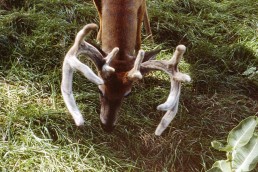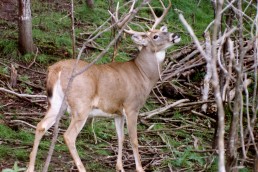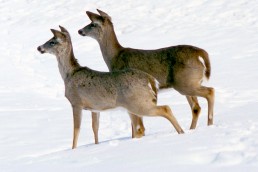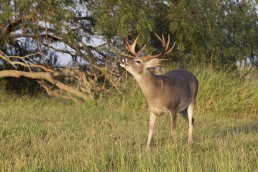How Human Scent Affects Hunted Whitetails part three
SHARE THIS POST
Like every other animal in deer country, wherever a whitetail hunter travels on foot, an invisible carpet of scents marks his passage. Oh sure, a hunter’s scent can be minimized by various means, but all those odoriferous molecules that continuously float away and drop to the ground and trailside foliage from a body, clothing, boots or hunting gear cannot be eliminated completely.
Among the most intense of unstoppable scents emitted by hunters are cooking odors, smoke and odors originating from his breath, any oral or skin bacteria, perspiration, hair, leather, his rubber boot soles and exhaust, fuel or oil fumes from an ATV or other off-road vehicle. Human odors that blanket a hunter’s path are detectable by whitetails’ noses four days or more unless it rains or snows. Within two days, one or more wandering still-hunters can create enough paths of these feared, persisting odors, making it very difficult for most or all whitetails living within a square mile to find a safe haven within their home ranges. Or, these scents will force many or all of the deer to temporarily abandon their ranges or become nocturnal. And hunters making drives can accomplish this just within hours.
Upon recognizing the smothering effect trail scents can have on whitetail hunting, my buck- hunting partners and I began adopting measures to minimize these as early as 1980.
Our first measure, aside from attempting to be as scent free as possible, was the decision to scout well before a hunting season begins. This was done to keep the year’s most concentrated network of trail scents—a consequence of thorough, five to eight days of preseason scouting—from affecting predictable habits and behaviors of our whitetails during a following hunting season.
Now and then, while scouting, we’d unexpectedly jump some stubbornly bedded deer at close range. This caused it to raise its tail and flee off-range, adding its path of ruinous odor to ours, scented with the ammonia-like odor released from the tarsal glands when it’s greatly alarmed. This odor not only warns other nearby deer of great danger via airborne routes, but while clinging to foliage along their trails it acts as a deer repellent for four or more days. After having discovered older bucks are inclined to remain off-range or become nocturnal up to two weeks after becoming alarmed enough to raise their tails and bound away, we decided it would be best to thereafter complete our preseason scouting no less than two to three weeks before a hunting season begins.
Measure number two adopted in 1991 was selecting trails that widely loop through our hunting area (connecting deer trails) or “cruise trails,” areas designated for limiting our wolf-inspired searches for fresh deer signs during a hunting season. This had had other unexpected benefits. It minimized our human trail scents during a hunting season much more than we initially realized. We also discovered our cruise trails helped to preserve sizable areas in our hunting area that were completely free of our trail scents, allowing many whitetails to maintain normal, predictable habits within large portions of their home ranges throughout a season.
Are you enjoying this post?
You can be among the first to get the latest info on where to go, what to use and how to use it!
Our cruise trails became our primary routes for reaching our once- or twice-used stand-site approach trails—these in turn were used to cautiously probe 100 yards or so into limited portions of adjacent whitetail home ranges not yet hunted, and especially the feeding areas discovered while scouting preseason. Because whitetails living along our cruise trails didn’t abandon their ranges, fresh tracks and/or droppings made by deer that crossed or used sections of our cruise trails were regularly found during our daily, midday and mid-hunt cruises in search of fresh deer signs—the next spots to stand-hunt.
Lacking snow yet again last year made it difficult to find and assess tracks made by mature bucks. More common droppings made by mature and yearling does then became our primary deer signs for deciding which nearby feeding areas to hunt. (Counting on eventually seeing a dominant breeding buck visiting a doe soon to be in heat or accompanying a doe currently in heat during hours that whitetails normally feed is what occasionally happened.)
As the hunting season progressed, it also became obvious we were now depositing trail scents on considerably fewer trails and also fewer miles of trails. In turn, this considerably reduced the odds of forcing our intended quarries to abandon our hunting area.
Though my hunting partners and I use many more stands sites than other stand-hunters, our unusual method of stand-hunting also actually contributes immeasurably to keeping older bucks and other whitetails from abandoning their ranges. Unless a mature whitetail unexpectedly discovers one of us a very short distance away, it won’t react with serious consequences. This is because we are completely predictable and harmless in appearance while searching for deer signs along our cruise trails during a hunting season; deer ahead typically move aside and merely watching us pass from cover. We are very difficult to identify while on our stand-site approach trails, and are always careful and keep our footsteps soft and avoid appearing or “sounding” as if we’re hunting.
We are very difficult to see, hear or smell by feeding deer out in front of our stand sites. And whenever a mature, downwind whitetail behind us, or crosswind on one side discovers us, what they see is a non-wandering, non-aggressive human that moves little and then very slowly who is free of strong odors and completely harmless in appearance. The only response that normally follows is that the deer will then temporarily keep 100 yards or more away from our stand site—four days or so if it’s a young deer, a week or more if it’s a mature doe, and the remainder of the hunting season for a mature buck. This is also a sensible precaution upon discovering a stand-hunter, but does not include one of us. We switch to unused stand sites 100 yards or more away, once or twice daily. Thus our unusual, somewhat complicated method of stand-hunting continues to enable my hunting partners and I to take our usual self-imposed quota of four, sometimes five, mature bucks per firearm hunting season despite the low numbers of stand-smart deer and any recent adverse weather.
No doubt about it—minimizing trail scents is well worth a hunter’s efforts.
MWO
SHARE THIS POST
Did you enjoy this post?
You can be among the first to get the latest info on where to go, what to use and how to use it!
Dr. Ken Nordberg
Based on his 55 years of field research, Dr. Ken Nordberg has written more than 800 magazine articles, 12 books on whitetails—including the famous Whitetail Hunter’s Almanac series—five books on black bear hunting and produced Buck and Bear Hunting School videos. You may peruse his encyclopedic website with whitetail hunting tips: drnordbergondeerhunting.com, his blog: drnordbergondeerhunting.wordpress.com, or social media pages.



